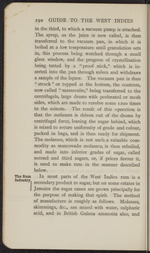| 1 |
 |
“...it is
boiled at a low temperature until granulation sets
in, this process being watched through a small
glass window, and the progress of crystallisation
being tested by a “proof stick,” which is in-
serted into the pan through valves and withdraws
a sample of the liquor. The vacuum pan is then
“ struck ” or tapped at the bottom, the contents,
now called “ massecuite,” being transferred to the
centrifugals, large drums with perforated or mesh
sides, which are made to revolve some 1200 times
to the minute. The result of this operation is
that the molasses is driven out of the drums by
centrifugal force, leaving the sugar behind, which
is mixed to secure uniformity of grade and colour,
packed in bags, and is then ready for shipment.
The molasses, which is not such a valuable com-
modity as muscovado molasses, is then reboiled,
and made into inferior grades of sugar, called
second and third sugars, or, if prices favour it,
is used to make rum in the manner described
below.
In most parts of the...”
|
|
